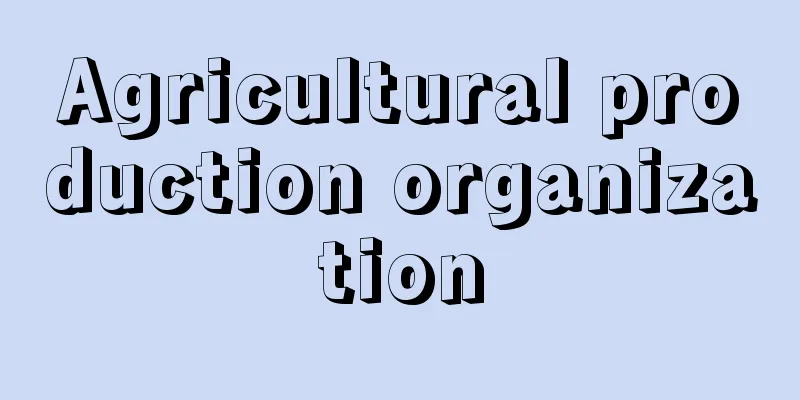Agricultural production organization

|
Much of Japan's agricultural production is carried out by small family-run businesses, but it is difficult for these businesses to maintain an appropriate scale of operation as agricultural productivity develops. For this reason, efforts have been made for multiple farmers to form organizations and introduce new technologies and machinery. An agricultural production organization can be described as "a production group in which multiple farmers (two or more) are united under an agreement to cooperate and unify part or all of the agricultural production process, or a group that systematically undertakes agricultural management and farm work" (Dictionary of Agriculture, Forestry and Fisheries Statistics, 2000). This term first appeared in the mid-1960s when agricultural machinery such as riding tractors began to become popular, and it had become so common that in the 1971 edition of the Agriculture White Paper it was stated that "today's individual farms will find it difficult to survive and develop without involvement of production organizations." Agricultural production is carried out by combining and utilizing productive resources such as labor, capital goods, intermediate products, and land. Therefore, agricultural production organizations, in which multiple farmers work together in the production process, also developed through the organized use of these production resources. Looking at the history chronologically, first, in the 1960s, organized use of labor power developed into cooperative work organizations. Collective paddy rice cultivation organizations, which focused on joint rice planting and cultivation agreements on standardizing varieties and water management, were representative of production organizations of this period and spread throughout the country. However, the number of such organizations decreased later, as part-time work became more prevalent and it became difficult for farmers to contribute equally to cooperative work. In the 1970s, a comprehensive mechanized system for rice cultivation was established, but there were some farmers, especially small-scale farmers, who did not own machinery such as tractors or combine harvesters. In addition, policies were implemented to encourage the introduction of medium- and large-sized machinery through subsidy programs such as the Agricultural Structure Improvement Program. In this period, the number of organizations involved in the use of capital goods such as agricultural machinery and facilities increased, and machinery joint-use associations and contract organizations that undertook machinery operations were established in various regions. In the latter half of the 1970s, problems arose such as soil depletion due to the heavy use of chemical fertilizers and pollution from manure caused by large-scale livestock farming, as a result of the expansion of the scale of monoculture farming. As a result, regional complex organizations were created to utilize intermediate products, for example by exchanging livestock manure from livestock farms with rice straw from crop farmers who were struggling to maintain their soil fertility. In the 1980s, as the problem of rice surplus arose, measures were taken to reorganize paddy field use, switching from rice cultivation to wheat and soybean cultivation. As part of this, in order to efficiently cultivate alternative crops, collective land use organizations were created that drew up land use plans for each region based on the agreement of landowners, regardless of the ownership of each individual piece of farmland, and consolidated farmland into several hectares for effective use. Thus, the formation of agricultural production organizations was carried out in the order of organization of labor, organization of capital goods, organization of intermediate product utilization, and organization of land utilization, depending on the historical background of each era. Also, in the process, farmers moved from joint utilization of each productive resource among themselves to the integration and integration of the organizational utilization of each of those productive resources from the 1980s onwards, that is, the formation of regional agricultural organizations that make effective utilization of the productive resources in a single region as a whole. Entering the 1990s, various forms of organizational activities began to be implemented, such as community-based farming, local farm systems, and local agricultural systems. In addition, some contracted organizations and community-based farming organizations have begun to incorporate as agricultural cooperative corporations, limited liability companies, or specified agricultural corporations. [Masa Umemoto and Masao Takahashi] "Agricultural Production Organization Research Group, ed., "Agricultural Production Organizations in Japan" (1980, Agriculture and Forestry Statistics Association)" ▽ "Complete Collection of Food and Agricultural Issues 4: Organizational Innovation in Regional Agriculture" by Masao Takahashi, edited by Nagao Shichinohe and Yoshito Jinnai (1987, Rural Culture Association)" [Reference] | |Source: Shogakukan Encyclopedia Nipponica About Encyclopedia Nipponica Information | Legend |
|
わが国の農業生産の多くは零細な家族経営により行われているが、それら経営では農業生産力の発展に伴ってそれに適した経営規模を確保することがむずかしい。そのため複数の農家が組織をつくってその新しい技術や機械を導入するという取り組みが行われてきた。農業生産組織とは、このように「複数(2戸以上)の農家が農業生産過程における一部もしくは全部についての共同化・統一化に関する協定の下に結合している生産集団又は農業経営や農作業を組織的に受託する集団」(『農林水産統計用語事典』2000年)といえる。 この用語は、乗用トラクターなどの農業機械が普及し始めた1960年代中ごろに登場し、1971年(昭和46)版の『農業白書』においては、「今日の個別経営は生産組織との係(かか)わりなしに存続、発展することは困難である」といわれるまでに一般化していった。 農業生産は、生産資源である労働力、資本財、中間生産物、土地を相互に組み合わせながら有効利用して行われる。したがって、生産過程において複数の農家が共同活動を行う農業生産組織も、それら生産諸資源の組織的な利用を通じて展開していった。 年代順にその経緯をみると、まず、1960年代は、労働力の組織的利用が共同作業組織として展開した。田植の共同作業と、品種の統一や水管理などに関する栽培協定を中心とする水稲の集団栽培組織は、この時期の生産組織の代表であり、全国各地に普及した。しかし、その後兼業化が進み、農家が平等に出役して共同作業を行うことが困難となったことなどから、その数は減少した。 1970年代に入り、稲作における機械化一貫体系が確立されたが、小規模層を中心に、トラクターやコンバインなどの機械をもたない農家が出てきた。また、農業構造改善事業などの補助事業を通して、それら中・大型機械の導入を促す施策が進められた。このような背景から、この時期には、資本財である農業機械や施設の利用をめぐる組織が増え、各地に機械共同利用組合や、機械作業を請け負う受託組織が設立された。 1970年代後半には、単作的な規模拡大が進められたことなどから、化学肥料の多投による地力消耗や、大規模畜産による糞尿(ふんにょう)公害といった問題が発生した。そのため、たとえば、畜産農家から生じる家畜糞尿と、地力維持に苦しむ耕種農家の稲藁(いなわら)とを互いに交換して利用するなど、地域複合組織とよばれる中間生産物の地域的な利用組織がつくられていった。 1980年代においては、米の過剰問題の発生に伴い、稲作から麦作や大豆作に転換する水田利用再編対策が進められた。そのなかで、転作作物の効率的な栽培を実施するために、個々の農地の所有権とはかかわりなく、地権者の合意に基づき、地域単位に土地利用計画をたて、農地を数ヘクタールの団地にまとめて有効利用するという集団的土地利用組織がつくられるようになった。 このように、農業生産組織の形成は、それぞれの時代背景のもとで、労働力の組織化、資本財の組織化、中間生産物利用の組織化、土地利用の組織化の順に進められた。また、その過程では、それぞれの生産資源に関する農家どうしの共同利用から、1980年代以降は、それら生産資源個々の組織的利用を相互につなぎ合わせ、総合化すること、すなわち、一つの地域において生産諸資源を総体として有効利用する地域農業組織の形成が図られるようになった。 1990年代に入ると、集落営農や地域農場制、地域農業システムといった多様な形態の組織活動が実施されるようになり、また、受託組織や集落営農組織の一部には、農事組合法人や有限会社、あるいは特定農業法人として法人化を図る事例も生まれてきている。 [梅本 雅・高橋正郎] 『農業生産組織研究会編『日本の農業生産組織』(1980・農林統計協会)』▽『高橋正郎著、七戸長生・陣内義人編『食糧・農業問題全集4 地域農業の組織革新』(1987・農山漁村文化協会)』 [参照項目] | |出典 小学館 日本大百科全書(ニッポニカ)日本大百科全書(ニッポニカ)について 情報 | 凡例 |
>>: Agricultural production index - nougyouseisanshisuu
Recommend
Installment sales - installment selling
A sales method in which the price of a product is...
Takanobu Ryuzoji
Year of death: March 24, 1584 (May 4, 1584) Year o...
Historical site - Shiseki
In a broad sense, a historic site is any place wh...
Izumin - Izumin
〘noun〙① A person who lives in seclusion away from ...
Neoceratodus (English spelling) Epiceratodus forsteri
A freshwater fish belonging to the Epiceratodus fa...
Acrostic (English spelling)
A word game in which the first or last letters of ...
Perdikkas
[Born] Around 365 B.C. [Died] 321 BCE He was one o...
teasel
...Distributed in Honshu, Shikoku, Kyushu, Korea,...
Inten
(Abbreviation of "Japan Art Academy Exhibitio...
Iinashigawa River
A river that flows through eastern Shimane Prefec...
Depression - Depression
…There are many unknowns about how animals commun...
Sfax (English spelling)
A port city on the Mediterranean coast in central...
Vachek, J.
... The first period of this school lasted until ...
Kourou (English spelling)
A town in northern French Guiana, northern South A...
Iveleth - Iveleth
The name Iberia comes from the fact that the anci...





![Kamiura [town] - Kamiura](/upload/images/67cb3eb183ae8.webp)



